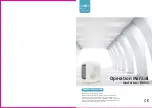
5565606-TIM-B-1018
Johnson Controls Ducted Systems
57
a post-purge. Normal operation is allowed concurrently with the
purge (i.e. this purge can be considered the purge associated
with a call for “W1”).
If “W1” is present, a flame is sensed, but the GV is not
energized, the draft motor is energized until the flame detection
is lost. Normal operation is now allowed.
The flame detection circuitry continually tests itself. If the ICB
finds the flame detection circuitry to be faulty, the ICB will not
permit an ignition sequence and the draft motor is energized. If
this failure should occur during an ignition cycle the failure is
counted as a recycle.
Gas Valve
The UCB and ICB continuously monitor the GV.
If the ICB senses voltage at the GV when not requested, the
ICB will energize the draft motor. The ICB will not operate the
furnace until voltage is no longer sensed at the GV. The draft
motor is stopped when voltage is not sensed at the GV.
Any time the UCB senses voltage at the GV without a call for
heat for a continuous five-minute period, the UCB will lock-on
the indoor blower. When voltage is no longer sensed at the GV,
the UCB will de-energize the indoor blower following the elapse
of the fan off delay for heating.
If voltage has been sensed at the GV for at least 15 seconds
during the fan on delay for heating and GV voltage or “W1” is
lost, the indoor blower is forced on for the length of the fan off
delay for heating.
During a call for heat, if the UCB does not sense voltage at the
GV for a continuous five-minute period the UCB will initiate a
error message. The indoor blower motor will not be locked-on
while there is no GV voltage.
Safety Controls
The UCB monitors the temperature limit switch of gas heat
units.
The control circuit includes the following safety controls:
Limit Switch (LS)
This control is located inside the gas heat compartment and is
set to open at the temperature indicated in the Gas Heat Limit
Control Settings Table 26. It resets automatically. The limit
switch operates when a high temperature condition, caused by
inadequate supply air flow occurs, thus shutting down the
heater and energizing the blower.
Auxiliary Limit Switch (ALS)
The auxiliary limit switch is wired in series with the limit switch.
As such, the UCB cannot distinguish the auxiliary limit and the
gas heat limit switch operation except the auxiliary is manual
reset. Consequently, the control will respond in the same
manner as outlined above under “Limit Switch”.
The ICB monitors the Pressure and Roll-out switches of gas
heat units.
The control circuit includes the following safety controls:
Pressure Switch (PS)
Once the draft motor has reached full speed and closes the
pressure switch during a normal ignition sequence, if the
pressure switch opens for 2 seconds, the GV will be de-
energized, the ignition cycle is aborted, and the ICB flashes the
appropriate code. See Table 32 Ignition Control Flash Codes.
The draft motor is energized until the pressure switch closes or
“W1” is lost.
Roll-out Switch (ROS)
The roll-out switch is wired in series with the pressure switch.
As such, the ICB cannot distinguish the roll-out switch operation
from that of the pressure switch.
Consequently, the control will only respond in the same manner
as outlined above under “Pressure Switch”. An open roll-out will
inhibit the gas valve from actuating.
Internal Microprocessor Failure
If the ICB detects an internal failure, it will cease all outputs,
ignore inputs, and display the proper flash code for control
replacement. The ICB remains in this condition until replaced.
Flash Codes
The ICB will initiate a flash code associated with errors within
the system. Refer to IGNITION CONTROL FLASH CODES
Table 32.
Resets
Remove the call for heating by lowering the thermostat setting
lower than the conditioned space temperature. This resets any
flash codes.
Gas Heat Anticipator Setpoints
It is important that the anticipator setpoint be correct. Too high
of a setting will result in longer heat cycles and a greater
temperature swing in the conditioned space. Reducing the
Table 26: Gas Heat Limit Control Settings
1
1. Roll-out = 300°F, Auxiliary Limit = 200°F.
Unit
Main Limit Setting
°F
Size
Opt.
ZWT06
(N,S)12
165
(N,S)18
165
ZWT07
(N,S)12
165
(N,S)18
165
ZWT08
(N,S)12
215
(N,S)18
195
ZWT10
(N,S)18
195
(N,S)24
160
ZWT12
(N,S)18
195
(N,S)24
160
















































